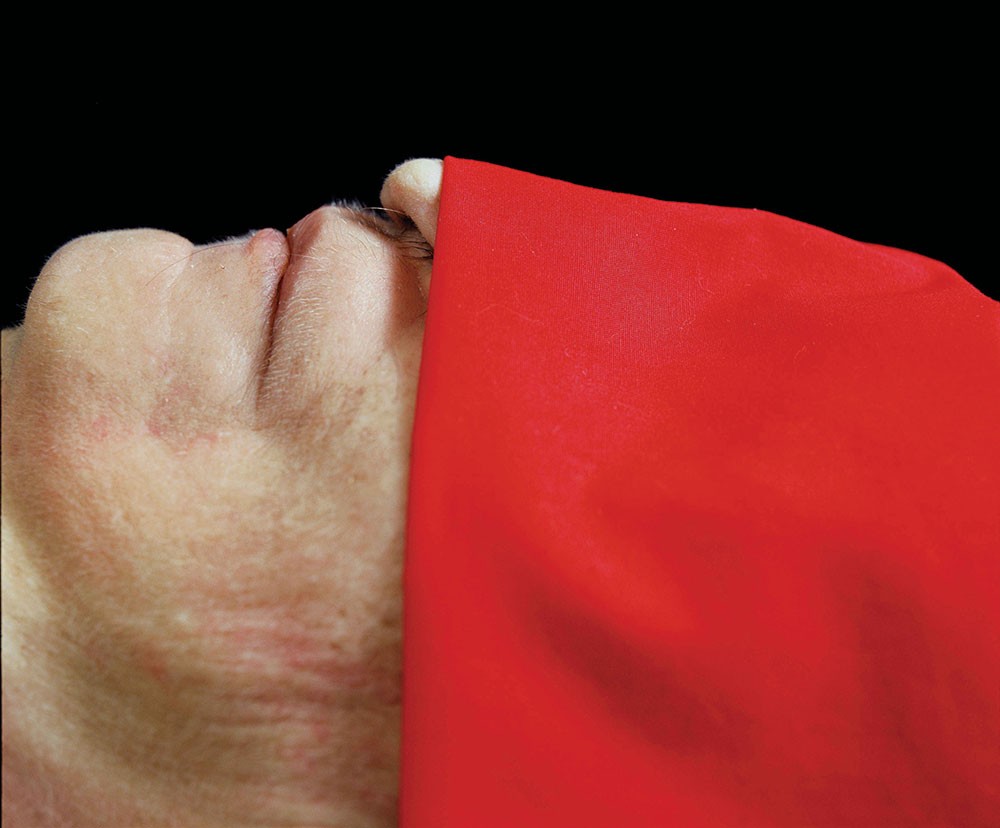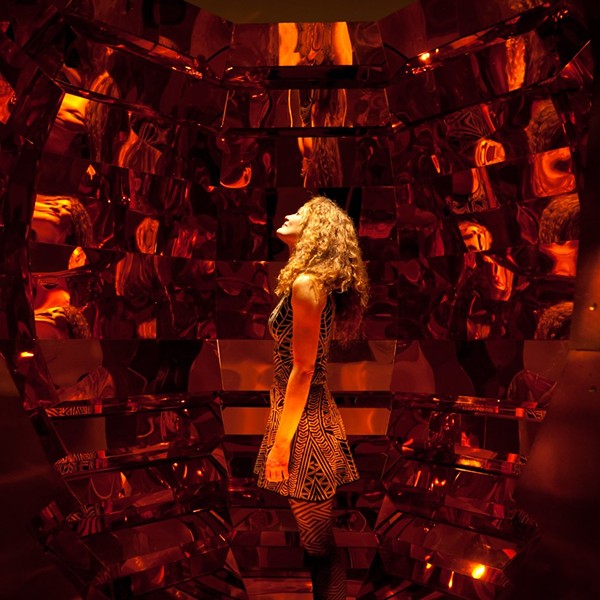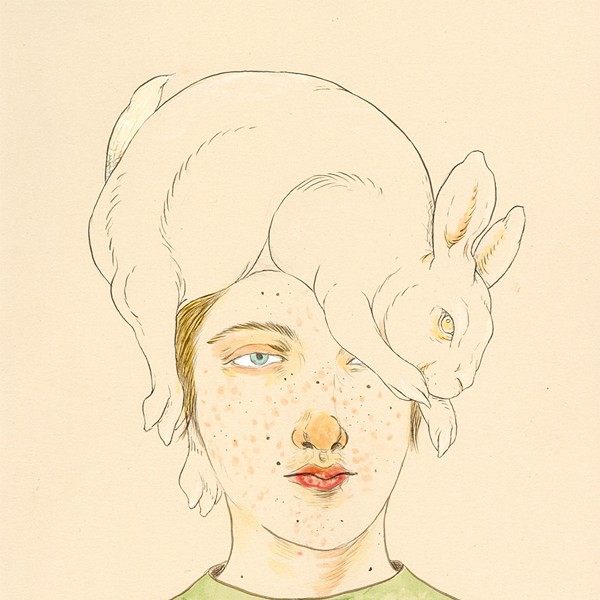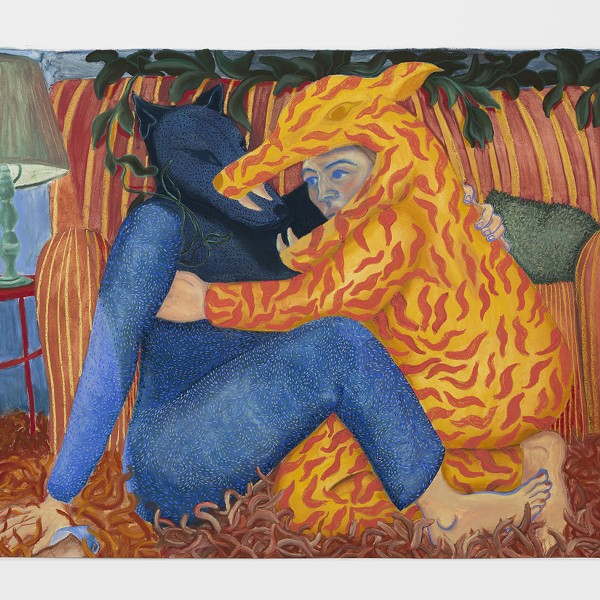
The Andres Serrano retrospective at The School, the spectacular exhibition space established by Chelsea gallery owner Jack Shainman in Kinderhook, is a rare event, given that the artist's work is shown far more frequently overseas than in the US. "I'm persona non grata in my own country," said Serrano, who attracted instant fame in 1987 for Piss Christ, a photograph of a plastic crucifix submerged in urine, which fueled the fire of the culture wars in the late '80s. Serrano's work has provoked boycotts, demonstrations, and violence, as evidenced by the large-scale pornographic photographs on display that were patched with red tape after being attacked by neo-Nazis in Sweden. "I thought the tape looked good, so I decided to leave it," Serrano says. "Whenever someone destroys my work it becomes something else. The work is open to interpretation, and sometimes it says more about the viewer than me."
Serrano, who was born in 1950 in New York City, is matter of fact about his use of bodily fluids, which are depicted in slick, large-scale photographs that reflect the influence of his work in advertising before he became an artist. He studied painting and sculpture at the Brooklyn Museum of Art as a teenager, and he first picked up the camera as an abstract artist: in 1985 he photographed two side-by-side tanks, one filled with blood and the other milk, for a show at the New Museum of Contemporary Art titled "Fake," a minimalist, formalist treatment inspired by Mondrian.
What followed was his notorious "Immersibles" series, represented in the exhibition by photographs depicting religious statuettes of the Madonna and child, Rodin's The Thinker and twin busts of the Pope blurrily submerged in a thick, yellow-orange light. The images of the classically elegant statuary are elegiac, suggesting intense sunsets on a particularly smoggy day, and it's only by reading the label that you learn the immersive substance is urine. Similarly, the silky, veil-like trail of white shooting across a black backdrop suggests cosmic phenomena, an association belied by the title, Ejaculate in Trajectory. (Serrano explained that it took him 30 tries and the use of a motorized camera before he was able to capture the image.) "The provocation is in the title, not the image," he said, noting that the title itself is "not offensive, but descriptive." In the "Red River" series, his strategy is more poetic, as the title emphasizes the landscape associations of the strange, textured substance resembling sumac berries that is actually wads of menstrual blood.
But other works are straight portraits that reflect his patriotism. In the "America" series, made in response to 9/11, the artist depicts a postal worker, firefighter, airline pilot and other personages connected to the attack on a heroic scale. (Not looking so heroic is a discombobulated-looking Donald Trump, from 2004.) Other images incorporate incongruities—for example, a black man posed as a Klansman and grown Siamese twins attached at the head who, dressed in Renaissance finery, are portrayed as genuflecting, courtly figures. (Serrano admits that he didn't see how he could transform the twins' squalid conditions into something beautiful at first, but with the help of a makeup artist, the Rembrandt-like costumes, and sensitive lighting he pulled it off.) "The camera lies and tells the truth at the same time," Serrano writes in the wall text. "There's confusion between reality and fabrication—sometimes I don't even know the difference."
A depiction of a person praying, from the "Nomad" series, which focuses on homeless people, was made after Serrano observed the person and asked her to re-create the pose. "I don't know if she was really praying," he said. There's less ambiguity in the "Torture" series, theatrical-style setups of models posed in a former foundry in France, which he likened to classical painting. Conversely, the three photographs from "Morgue" are unnervingly real. Serrano avoided identifying the dead person by focusing on a portion of the body, a discretion that results in surprisingly moving images. In Fatal Meningitis, for example, which depicts a pair of tiny feet, a pink ribbon tied around one ankle and the skin still bearing the impress of socks point to the child's recent life.
Upstairs, The School is exhibiting "Home Room," a group show of international artists. Turiya Magadelela, who is South African, stretches ripped and sewn pantyhose over white canvases, creating translucent, grid-like patterns in which squares of intense magenta and pink or washes of pale gray and green protest the sexist patriarchy while being anchored in an abstract, Modernist vocabulary. Huma Bhabha's room-size assemblage crafted from industrial detritus, entitled Thot and Scribe, commemorates the war-torn landscape of her native Pakistan while also referencing destroyed monuments and ancient Egyptian mythology. The School is noted for its multicultural roster of artists, and now, more than ever, such an exhilarating diversity of work is essential viewing. "Andres Serrano: Selected Works 1984-2015" will be exhibited through April 30. (518) 758-1628; Jackshainman.com/school.
—Lynn Woods
















